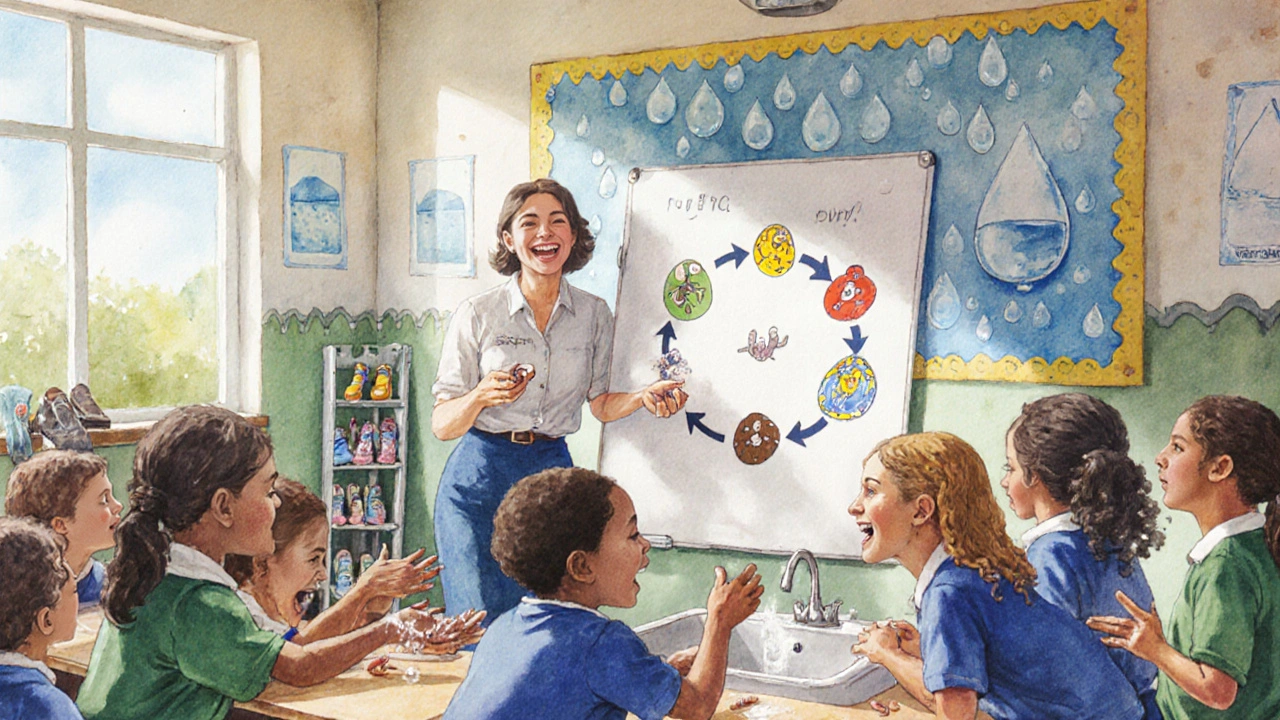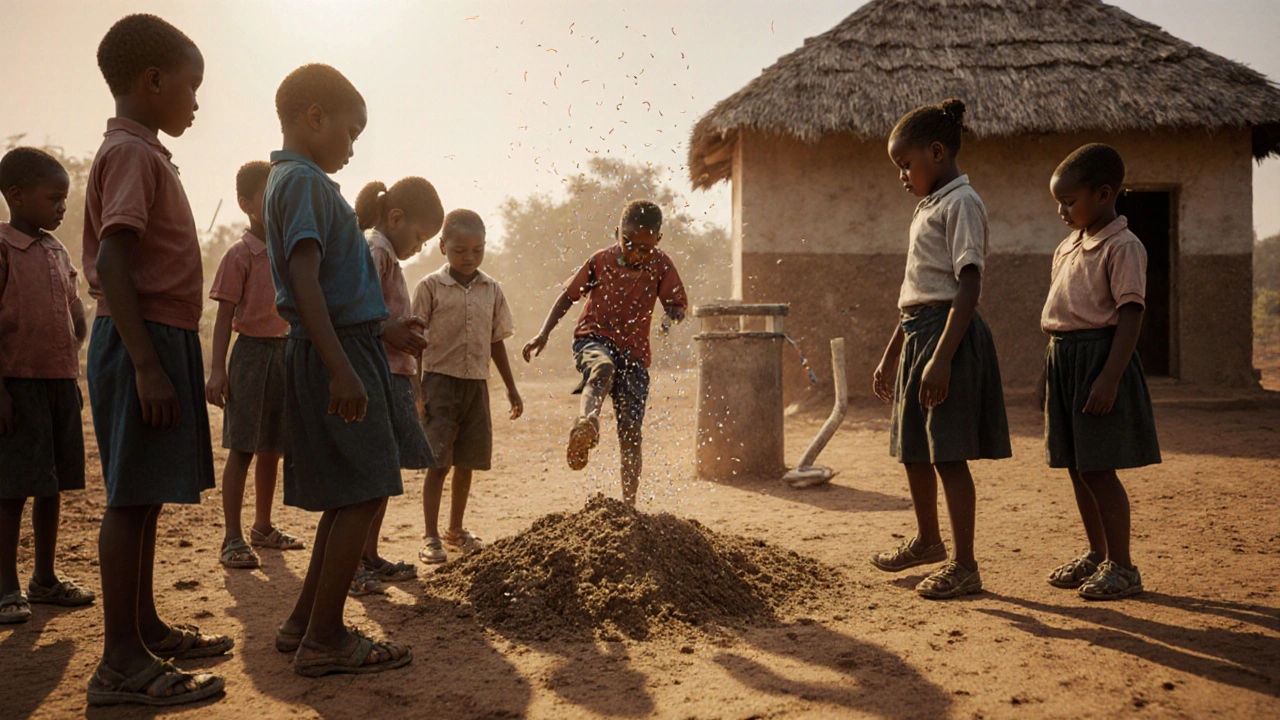Worm Infection Prevention Impact Calculator
Educational Intervention Factors
Adjust the sliders below to estimate the impact of different educational strategies on reducing worm infections.
Estimated Impact on Worm Infections
Progress Tracking
worm infections are caused by soil‑transmitted helminths like Ascaris, Trichuris, and hookworms. They thrive where sanitation is poor and affect billions, especially children in low‑income regions. While medicines clear the parasites, lasting change needs more than pills - it needs people to understand how they spread and how to stop it.
Key Takeaways
- Education improves hygiene practices that directly lower infection rates.
- School‑based programs combine health talks, clean water, and regular deworming for maximum impact.
- Tailored curricula that link parasite life cycles to daily habits boost retention.
- Monitoring behavior change is as important as tracking infection numbers.
- Community involvement ensures messages stay alive after schools close.
Why Worm Infections Persist
Even with free deworming tablets, prevalence remains high in areas lacking clean water and proper latrines
. Children often play barefoot in contaminated soil, wash hands with unclean water, and eat unwashed produce. These habits are rooted in daily routines, not ignorance. When the environment stays risky, reinfection can happen within weeks after treatment.How Education Changes Behavior
Health education uses simple, relatable messages to teach preventive actions
-like washing hands with soap before meals or wearing shoes outdoors. Studies from the WHO (World Health Organization) show that schools delivering structured health lessons see a 30‑40% drop in infection rates after two years, even without increasing drug coverage.The magic lies in behavior change communication (BCC). BCC frames information as stories, games, or songs that stick in young minds. When children repeat the messages at home, parents often adopt the practices too, creating a ripple effect.
School‑Based Programs That Work
Successful initiatives share three pillars:
- Curriculum integration: Teachers embed parasite life‑cycle lessons into science or geography classes.
- Practical activities: Hand‑washing stations, shoe‑distribution drives, and school gardens with safe irrigation.
- Regular deworming: Coordination with national drug‑distribution campaigns, usually twice a year.
For example, Kenya’s “Worms No More” program combined weekly five‑minute talks with teacher‑led demonstrations of hand washing. Over three years, infection prevalence among participating schools fell from 45% to 12%.

Designing an Effective Curriculum
Start with the parasite lifecycle (egg → soil → human → adult)
. Visual aids showing each stage help kids see where they can intervene. Next, tie each stage to a simple action:- Eggs in soil → wear shoes.
- Larvae on vegetables → wash produce.
- Adult worms in intestines → take deworming tablets.
Use role‑play: one child pretends to be a worm, another a teacher explaining how soap kills the worm’s chances. Such interactive methods increase recall by up to 70% compared with lecture‑only formats.
Measuring Impact Beyond Labs
While stool tests confirm infection rates, they’re costly for routine monitoring. Instead, track proxy indicators:
| Indicator | How to Measure | Target Change |
|---|---|---|
| Hand‑washing frequency | Spot checks at school sinks | +50% in 6 months |
| Shoe‑wear compliance | Weekly head‑teacher reports | 90% of students |
| Knowledge retention | Short quizzes after lessons | 80% correct answers |
Pair these with annual prevalence surveys to see the full picture. When knowledge scores rise while infection numbers fall, you know education is paying off.
Common Pitfalls to Avoid
1. One‑size‑fits‑all messages: Rural communities may miss messages about tap water if they rely on wells. Tailor content to local water sources.
2. Ignoring teachers’ workload: Overburdened staff may skip lessons. Provide ready‑made lesson packs and brief training sessions.
3. Forgetting follow‑up: A single talk won’t stick. Schedule refresher sessions every term.
Next Steps for Communities
Engage community health workers who can reinforce school messages at home
. Organize village meetings where parents learn to make low‑cost soap and build latrines. Coordinate with the World Health Organization guidelines for integrated parasite control to align fundraising and drug procurement.Finally, document successes-photos of hand‑washing stations, kids wearing shoes, reduced absenteeism. Share these stories with local media to keep momentum alive.
Frequently Asked Questions
How often should schools conduct health education sessions on worm infections?
Ideally, a brief 5‑minute session each week keeps the message fresh, complemented by a more detailed lesson every term.
Can education replace the need for deworming medication?
No. Education reduces reinfection risk, but periodic deworming is still required to clear existing parasites.
What low‑cost tools help teach children about parasite lifecycles?
Printed flip‑charts, simple clay models of worms, and interactive songs or games can be produced locally for under $2 per class.
How do we measure if behavior change is happening?
Track hand‑washing stations usage, shoe‑wear rates, and conduct short knowledge quizzes. Compare baseline data with follow‑up results every six months.
What role do parents play in sustaining the education impact?
Parents reinforce hygiene habits at home, help children practice hand washing, and ensure shoes are worn. Involving them in school meetings boosts adherence.


12 Comments
October 1, 2025 Francesca Roberts
Looks like you've crammed a whole public health lecture into a widget-nice work. The basic idea is that teaching kids to wash their hands and wear shoes can actually cut worm loads, which is kind of mind-blowing if you’ve ever seen a kid with shoes on a dusty field.
Even though the math in the calculator is simple, the real impact comes from sticking those lessons in school curricula and community meetings.
And yes, you’ll still need the deworming pills; education alone won’t magically zap every worm. Congrats on reinventing the wheel, definatly impressive.
October 8, 2025 Becky Jarboe
From an epidemiological standpoint, the intervention leverages behavior change communication (BCC) to shift the transmission dynamics of soil‑transmitted helminths. By augmenting hand‑washing frequency (ΔHW) and shoe‑wear compliance (ΔSW), the model approximates a reduction factor (R) = 0.3·ΔHW + 0.4·ΔSW + 0.3·ΔKR, aligning with WHO’s integrated control framework.
Operationalizing this requires modular lesson plans, peer‑to‑peer reinforcement, and a feedback loop of knowledge assessments to calibrate ΔKR over successive terms.
October 15, 2025 Carl Boel
It’s absurd that any country can claim to have “solved” worm infections while ignoring basic personal hygiene. The moral imperative is clear: governments must enforce hand‑washing stations and shoe distribution as part of a national health agenda, not just hand out pills and hope for the best.
If you’re not integrating education into the core curriculum, you’re effectively neglecting your citizenry’s right to a worm‑free life.
October 22, 2025 Shuvam Roy
Thank you for outlining a comprehensive framework. The inclusion of measurable proxies such as hand‑washing frequency and shoe‑wear compliance is particularly valuable for program monitoring.
Ensuring that teachers receive concise training modules will help maintain fidelity to the curriculum without overburdening their existing responsibilities.
I would recommend quarterly data reviews to adjust the educational content based on observed behavioral trends.
October 29, 2025 Jane Grimm
While the proposal is commendably thorough, one must caution against overly optimistic projections without accounting for socioeconomic constraints. The assumption that 90 % shoe compliance is attainable neglects the realities of impoverished households where footwear may be a luxury.
Moreover, the language employed in the curriculum should avoid colloquialisms that could alienate non‑native speakers; precision in terminology is paramount.
November 5, 2025 Nora Russell
The analytical model, albeit elegantly simplified, suffers from an overreliance on linear weighting coefficients that may not capture the synergistic effects observed in field studies. A multivariate regression approach could yield a more nuanced understanding of how hand‑washing, footwear, and knowledge retention interact.
Furthermore, the absence of a sensitivity analysis leaves stakeholders unable to gauge the robustness of the projected reduction.
November 12, 2025 Craig Stephenson
I see your point about the modeling limitations. Perhaps a mixed‑methods evaluation-combining quantitative surveys with qualitative focus groups-could address the gaps you highlighted. This would allow us to triangulate the data and refine the weighting scheme accordingly.
November 19, 2025 Tyler Dean
They’re hiding the fact that big pharma profits from endless deworming cycles.
November 26, 2025 Susan Rose
It’s great to see a health initiative that respects local traditions while bringing in new hygiene practices. Partnerships with community leaders can make the difference between a short‑lived campaign and lasting change.
December 3, 2025 Eve Perron
The article presents a compelling case for integrating educational components into worm‑control programs, recognizing that knowledge alone can alter the epidemiological landscape.
However, the success of such interventions hinges on cultural relevance; what works in one region may be ineffective in another if the messaging does not align with local belief systems.
It is therefore essential to conduct formative research, including ethnographic observations and stakeholder interviews, before finalizing curriculum content.
By mapping the community’s existing hygiene practices, implementers can identify leverage points where simple behavior modifications-such as the habit of washing hands before meals-can be introduced without imposing foreign norms.
Moreover, gender dynamics often influence who is responsible for water collection and food preparation, and these roles must be reflected in the educational materials to ensure equitable adoption.
The proposed use of interactive tools, such as role‑play exercises where children embody parasites, offers an innovative avenue to embed scientific concepts in memorable narratives.
Yet, one must be cautious not to oversimplify the parasite lifecycle to the point of trivializing the health risks associated with infection.
The inclusion of quantitative indicators-hand‑washing frequency, shoe‑wear compliance, and knowledge retention scores-provides a pragmatic framework for monitoring progress.
These proxy measures, while useful, should be complemented by periodic parasitological surveys to validate that behavioral changes translate into reduced infection prevalence.
In addition, establishing a feedback mechanism wherein teachers receive real‑time data on student performance can foster a culture of continuous improvement.
The article’s suggestion to involve community health workers in reinforcing school‑based messages is particularly astute, as it bridges the gap between institutional learning and household practice.
Nevertheless, sustainability will require securing financing for supplies such as soap and durable footwear, which are often overlooked in grant proposals.
Engaging local micro‑enterprises to produce low‑cost shoes could stimulate the economy while simultaneously advancing public health goals.
Finally, disseminating success stories through local media can amplify the program’s impact, encouraging neighboring communities to adopt similar strategies.
In sum, a holistic approach that couples education with infrastructure, supply chains, and robust monitoring will be the cornerstone of lasting reductions in worm infections.
December 10, 2025 Josephine Bonaparte
Wow, that was a fantastic deep‑dive! I love how you stressed the need for community input and even suggested local shoe makers-makes total sense. Just a heads‑up: remember to keep the language simple for the kids, maybe add some colorful pictures so they stay engaged.
December 17, 2025 Meghan Cardwell
Great summary! Using jargon like “behavior change communication” reminds us that the science behind these interventions is solid, and the colorful examples keep it accessible for everyone involved.
Write a comment